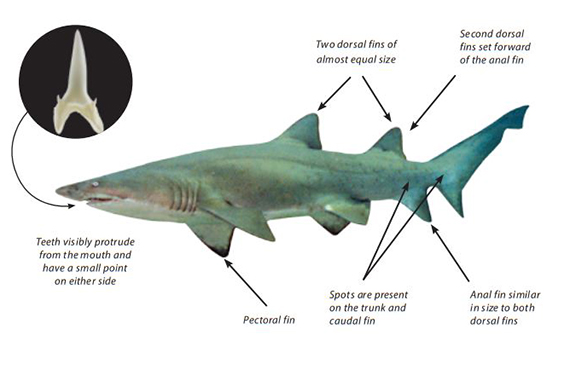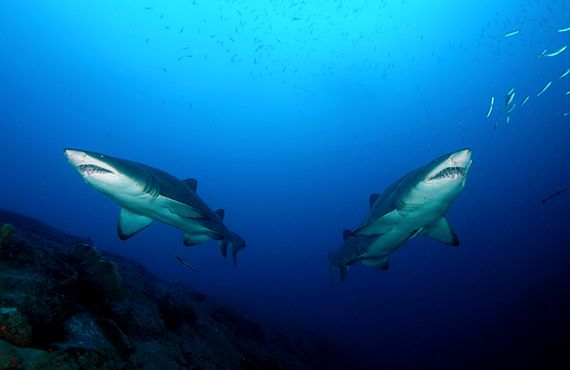
Greynurse shark
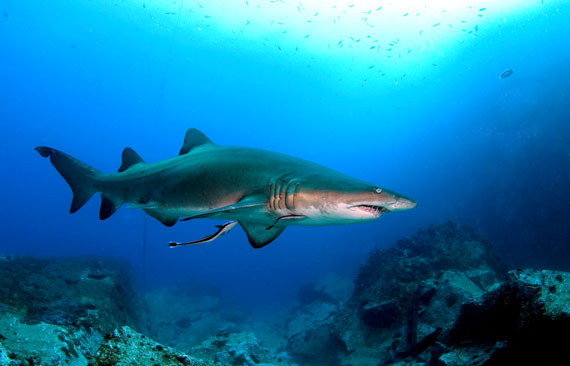
Scientific name
Carcharias taurus
Status in NSW
Critically endangered.
Characteristics
The Grey Nurse Shark, also known as the sand tiger shark or spotted ragged-tooth shark, has a large, stout body tapered at each end, a pointed snout and small eyes. The upper surface of Greynurse Sharks is bronze coloured, and the underside is pale white. Juveniles often have dark spots on the lower half of the body and the caudal (tail) fin. These spots fade as the shark becomes larger, but sometimes persist on adults. They have two distinctive large dorsal (top) fins of similar size. The first dorsal fin is set well back from the pectoral (side) fins. The anal fin is similar in size to both dorsal fins. The mouth extends beyond the front of the eye, and has long, protruding teeth.
Species similar in appearance
Whaler Sharks.
Size
Greynurse Sharks are born at around 1 metre and can grow to a maximum length of 3.2m.
Distribution
The Australian east coast population of Greynurse Sharks aggregate at, and migrate between a number of key sites along the coast of NSW and southern Queensland from Montague Island in the south to Fraser Island in the north.
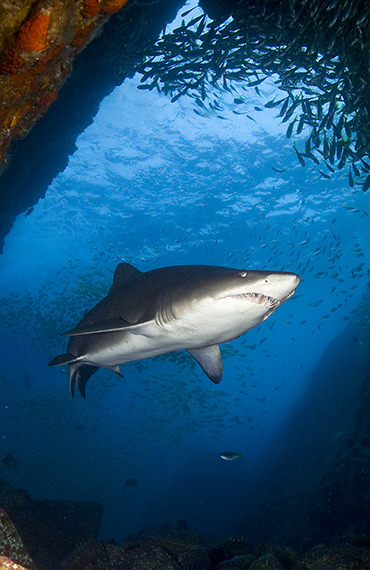
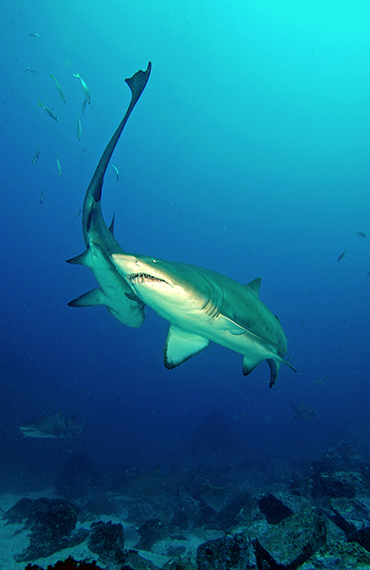
Habitat
Greynurse Sharks are predominantly found in inshore coastal waters. They are likely to be seen to cruising around sandy bottoms and rocky caves, and close to reefs and islands. They have been recorded at depths up to 232 metres, but spend most of their time in waters less than 40 metres.
Greynurse Sharks congregate at a number of sites along the coast of NSW and southern Queensland, known as "aggregation sites". These sites have rocky reef with gravel or sand filled gutters, overhangs or caves. Greynurse Sharks are known to travel hundreds of kilometres between aggregation sites in short periods of time, returning to the same sites in consecutive years.
Why is the Greynurse Shark threatened?
- Hook and line fishing in areas important for the survival of threatened species has been identified as a key threatening process affecting Greynurse Sharks
- Accidental hooking on commercial and recreational fishing gear can result in internal injuries and death
- Historical declines in numbers due to targeted fishing and hunting
- Capture in beach safety (shark) mesh nets
- Illegal capture for sale of the fins
- The species’ very low potential for population recovery
More information
- Fisheries Scientific Committee final determination (PDF, 43.38 KB)
- Fishing and diving rules at Greynurse Shark aggregation sites
- Greynurse Shark critical habitat and aggregation sites maps
- Protecting the Greynurse Shark - a guide for recreational fishers and divers (PDF, 2366.52 KB)
- Priorities Action Statement - Actions for Greynurse Shark
- Primefact: Greynurse Shark
- 2002 Section 8 notification (PDF, 1294.66 KB) (to be read in conjunction with 2013 Section 8 Notification)
- 2022 Section 8 notification (PDF, 849.7 KB)
- Recovery planning strategies for Greynurse Sharks
- Review of Greynurse Shark protection
- National Recovery Plan

